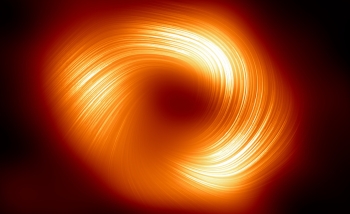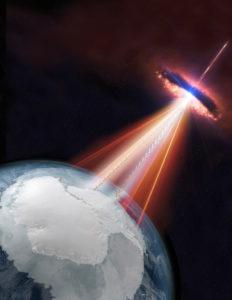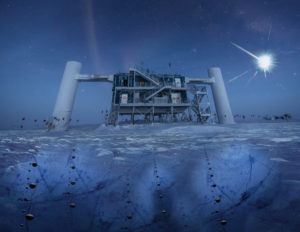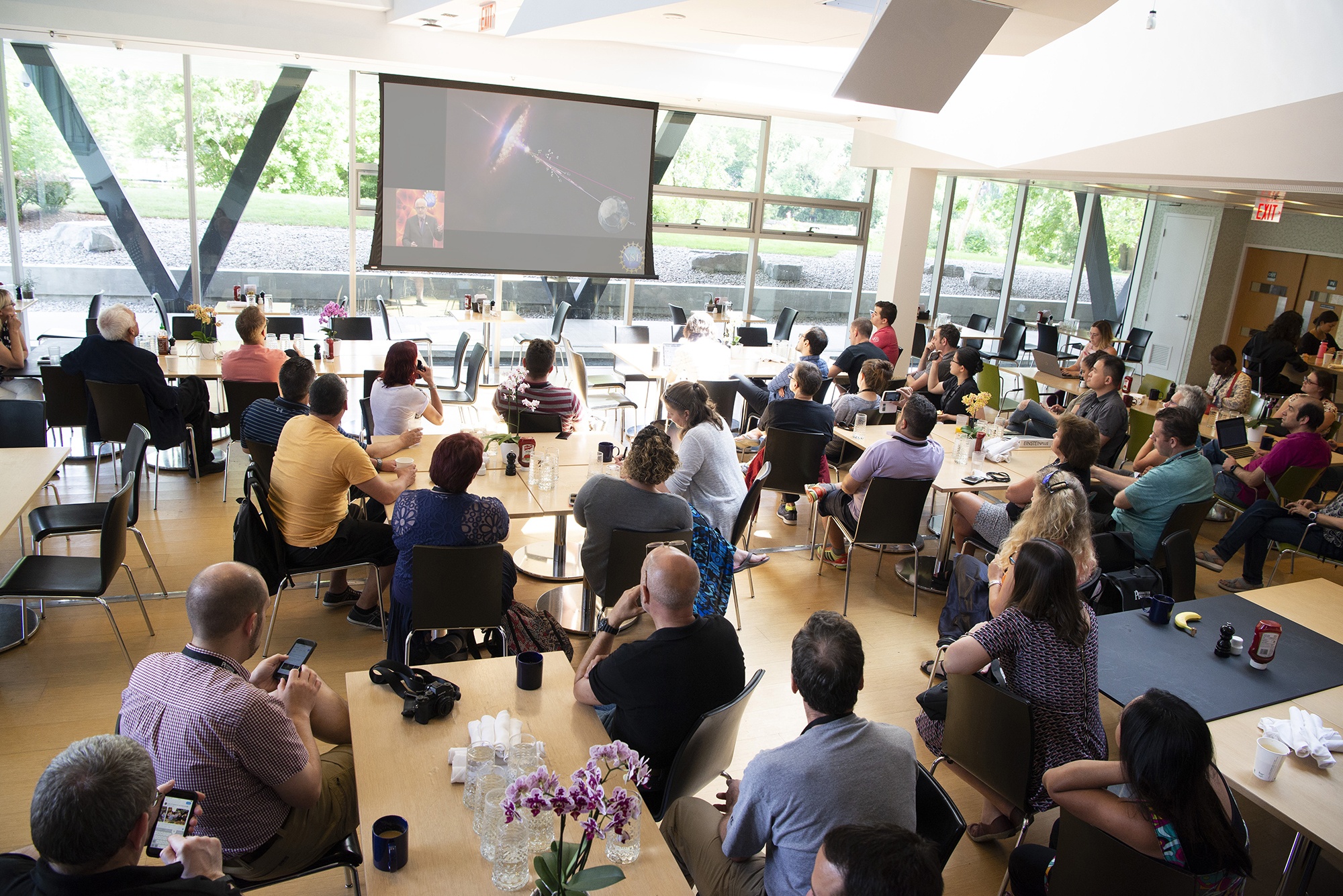A single high-energy neutrino that flashed through Antarctic ice in September 2017 acted as a new cosmic courier in the fast-moving enterprise of multimessenger astronomy – and heralded a breakthrough in a 106-year-old mystery in the process.
When the IceCube Neutrino Observatory detected this unusually high-energy neutrino, they sent a notice out to telescopes around (and above) the world to let them know what direction it came from.
The Fermi Gamma-ray Space Telescope responded to the call and sent back exciting news: they knew exactly where the neutrino had come from, and the source was spectacular.
Four billion light years away, in the constellation Orion, an active galaxy known as a “blazar” lies tucked under the hunter’s arm. The supermassive black hole – millions to billions of times the mass of our sun – at the centre of the galaxy accelerates the gas around it, shooting out energetic jets of radiation and particles travelling at near light speed. (Blazars are the specific case when the jets happen to be directed toward Earth.)
Blazars are a type of active galaxy with one one of its jets pointing toward us. In this artistic rendering, a blazar emits both neutrinos and gamma rays that could be detected by the IceCube Neutrino Observatory as well as by other telescopes on Earth and in space.
(Credit: IceCube/NASA)[/caption]
Fermi could see the gamma-rays created when particles in these jets collided.
The discovery marks the first time the source of an extra-galactic neutrino has been definitively identified and another major success for the burgeoning field of multimessenger astrophysics.
“This result is the first of its kind. We have never before used multimessenger astrophysics to pinpoint the origins of high-energy cosmic rays,” said France Córdova, Director of the National Science Foundation, during the press conference announcing the findings.
“We can better understand the universe’s immense cosmic accelerators. We still can’t produce anything with nearly the energy of these cosmic particles, so we have to turn to the heavens to deepen our understanding of the highest-energy processes.”
Neutrinos are elusive subatomic particles that zip through the universe at nearly the speed of light. They are neutral, meaning they lack an electrical charge, and don’t interact via the electromagnetic force, so they are notoriously difficult to detect and to track. We can see them only when one happens to crash into the nucleus of an atom. Given a detector the size of your body, Córdova said, you would measure such a collision only once every 100,000 years.
To maximize the chances of detecting a neutrino, you need many neutrino detectors. That’s where the IceCube Neutrino Observatory comes in.
Located at the Amunsden-Scott South Pole Station in Antarctica, the detector sits within a cubic kilometre of crystal-clear ice (containing more than a billion tonnes, or 1038 atoms to collide with) that is permeated by more than 80 long strings of sensitive equipment. Dotted along those strings, like pearls on a necklace, are thousands of digital optical monitors, ready to detect the radiation produced when a neutrino crashes into an atom.
Neutrinos and cosmic rays go hand-in-hand: the same physical processes that produce cosmic rays produce neutrinos as well. That means neutrinos can act as a proxy for gleaning information about cosmic rays (which, despite the moniker, are not rays at all, but rather high-energy protons and atomic nuclei that constantly bombard the Earth from space).
Determining the source of cosmic rays is next to impossible; as charged particles, their paths are bent and twisted by magnetic fields they encounter as they travel across the universe. Once they arrive at Earth, they collide with particles in the atmosphere, further obscuring their origins.
Neutrinos, by contrast, are straight shooters. As elusive as they are, neutrinos’ ghostliness confers a great advantage: since they don’t interact with light or magnetic fields, they travel unimpeded on straight paths through the universe – and those paths point straight back to where they came from.
“The goal is to track cosmic ray sources by looking for neutrinos. They will point back at the source because they are neutral particles,” said Francis Halzen, IceCube principal investigator from the University of Wisconsin-Madison. “On September 22, 2017, that’s exactly what one neutrino did.”
Within 43 seconds of the detection, the IceCube detectors reconstructed the energy and the direction of the neutrino and blasted the information out to the broader astronomical community. In the end, more than 20 telescopes looked in the direction of the event, each adding another piece of information to the puzzle.
In this artistic composition, based on a real image of the IceCube Lab at the South Pole, a distant source emits neutrinos that are detected below the ice by IceCube sensors, called DOMs.
(Credit: IceCube/NSF)[/caption]
“The beauty of this is that if Fermi hadn’t found the blazar, it would have been just another neutrino detection for us,” said Halzen. “For Fermi, it would have been just another blazar event. It was elevated to a discovery of a cosmic ray source by having the two telescopes working in unison.
“That was only the beginning. Once we knew of an interesting direction in the sky, we looked back at years of data on tapes and disks in that direction. We found that in 2014, there was a flare in neutrinos – more than 12 that came in 150 days.”
The energies of the neutrinos matched exactly what theory would predict from a cosmic accelerator such as a blazar.
Being able to study the high-energy universe via neutrinos unlocks a wealth of new possibilities, according to Niayesh Afshordi, a Perimeter Associate Faculty member. “Photons have been historically the only way we’ve managed to learn about the universe – so using neutrinos is a really novel way of seeing these things,” he said.
“This simultaneous observation of gamma rays and neutrinos basically tells us what might be responsible for the origin of gamma rays – because it must be something that produces neutrinos at the same time. That narrows down the range of possibilities in a very dramatic way. That’s really the exciting thing. You can exponentially narrow the range of possibilities if you have multiple probes of a physical process.”
Perimeter Associate Faculty member Cliff Burgess watched the announcement as it was live-streamed in Perimeter’s Black Hole Bistro. The announcement serendipitously coincided with the 2018 Tri-Institute Summer School on Elementary Particles (TRISEP), an international summer school organized jointly by Perimeter Institute, SNOLAB, and TRIUMF, and held this year at Perimeter, where Halzen was also an invited speaker.
“Francis did an amazing thing for us,” said Burgess. “We invited him before any of this was in the cards, as far as we knew. What normally happens in this case is that the researcher will say, ‘There’s some nice thing that’s going to happen, but I’m embargoed, and I can’t tell you about it.’”
Instead, Halzen devoted one of his lectures to sharing the findings with the students. “He said it was the first time he had told anybody. This was his first talk on it, to students at this school. For a school, that never happens. It was just spectacular,” Burgess said. “He was getting feedback – clearly the students were engaged. They were the first people in the world to see it. That’s phenomenal.”
Burgess said that, as a theorist, he’s most interested to find the holes and missing edges in the puzzle as it is pieced together: “There are going to be flaws in the picture. There’s going to be things that won’t quite work at first, and that’s where the excitement is.”
Afshordi added: “This is kind of the birth of multimessenger astronomy, with gravitational waves and neutrinos, and I think it’s going to get much more exciting. You can do actual astronomy with it, with many objects and various surveys that will happen hopefully over the next few decades.”
Further exploration
- Watch: View the NSF press conference on the breakthrough.
- Watch: View the NSF press conference on the breakthrough.
- Find out more: Read the papers in Science as was as companion follow up papers and view the IceCube FAQ about the results.
- Free resources: Click to download Perimeter's free lesson "Where Did All the Neutrinos from the Sun Go?"
- Related: Neutron star collision sparks new era of discovery
About PI
Perimeter Institute is the world’s largest research hub devoted to theoretical physics. The independent Institute was founded in 1999 to foster breakthroughs in the fundamental understanding of our universe, from the smallest particles to the entire cosmos. Research at Perimeter is motivated by the understanding that fundamental science advances human knowledge and catalyzes innovation, and that today’s theoretical physics is tomorrow’s technology. Located in the Region of Waterloo, the not-for-profit Institute is a unique public-private endeavour, including the Governments of Ontario and Canada, that enables cutting-edge research, trains the next generation of scientific pioneers, and shares the power of physics through award-winning educational outreach and public engagement.
You might be interested in


Why we have not discovered dark matter: A theorist's apology | Public Lecture
February 1, 2024



